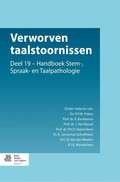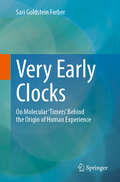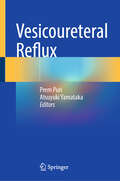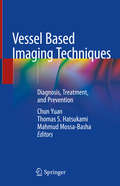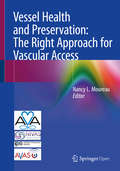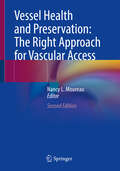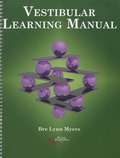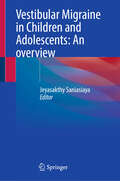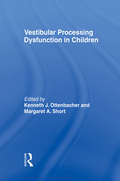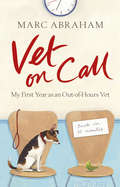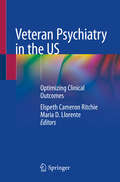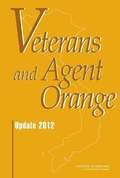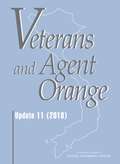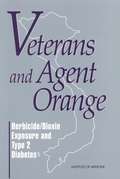- Table View
- List View
Verworven taalstoornissen
by R. Bastiaanse P.H.O. Dejonckere K. Jansonius-Schultheiss B.J.E. Mondelaers H.F.M. Peters J. Van Borsel Sj. Van der MeulenHet Handboek Stem-Spraak-Taalpathologie verscheen tussen 1997 en 2007 gefaseerd in losse afleveringen. Daarin werd alle kennis op het gebied van de stem-, spraak- en taalpathologie vanuit verschillende disciplines samengebracht. Het Handboek is bestemd voor iedereen die klinisch-praktisch of meer theoretisch is geïnteresseerd, of vanuit een ander vakgebied hiermee in aanraking komt. Voor logopedisten, artsen, linguïsten, spraak- en taalpathologen, audiologen, pedagogen en psychologen in Nederland en België is het Handboek een onmisbare vraagbaak.Deel 19 is geheel gewijd aan verworven taalstoornissen.
Very Early Clocks: On Molecular 'Timers' Behind the Origin of Human Experience
by Sari Goldstein FerberThis book highlights the main rhythms of human behavior and experiences early in life, during gestation. It discusses their underlying molecular mechanisms as they develop in clockwise patterns. The book offers a comprehensive view of prenatal rhythms, showing their complexity, unlike traditional views that assume linearity. Part 1 presents the latest data on structural rhythms of cerebral development, including the birth of the first neuron, neural wiring, myelination and inter-regional growth. These processes are described as they emerge from genome activation, followed by combinations of tissue- and time-specific gene expression. The transcriptomic architecture is discussed, alongside the development of antioxidative defenses. Part 2 focuses on the rise of early psychological phenomena, as they develop from time-sensitive molecular processes. Part 3 provides an integration and a breakthrough in understanding clock genes during gestation beyond their photic reactivity. Using novel data on clock genes, the author presents a model to describe their ultradian oscillatory reactions to electrochemical and structural conditions. This synthesis, summarized in an equation, bridges thermodynamics, Control Systems Theory, electrochemical principles, and Boolean functions. This book speaks to all readers interested in understanding the origin of human experiences, especially the crucial role of &‘timers&’ during gestation. This book will be of interest to scientists for further studies, to teachers and students for further learning in academic courses, and to clinicians who wish to refine their diagnostic examinations during gestation.
Verzorgen van barenden, kraamvrouwen en pasgeborenen: Werkcahier Kwalificatieniveau 3 311 (Skillslab-serie)
by Hogeschool van Arnhem en Nijmegen Diana Dekker Heleen GoedegebuurDit werkcahier besteedt aandacht aan de (aanstaande) moeder en de pasgeborene. Van de kraamverzorgende wordt verwacht dat zij de behoefte en de noodzaak van informatie en advies kan inschatten en die op de juiste wijze kan verwoorden. Dit vooral met betrekking tot de persoonlijke verzorging vaan de kraamvrouw en de baby de begeleiding rondom borstvoeding en flesvoeding, en vragen over het slapen en huilen van de pasgeborene.
Vesalius: The China Root Epistle
by Daniel H. Garrison Andreas VesaliusThis book provides the first annotated English translation from the original Latin of Andreas Vesalius' China Root Epistle. Ostensibly his appraisal of a fashionable herbal remedy, the China Root Epistle concentrates on Vesalius' skeptical appraisal of traditional Galenic anatomy, which was based on animal rather than human dissections. Along with reflections about his life as a young anatomist, Vesalius argued that the new science of anatomy should devote itself less to rhetorical polemics and more to the craft of direct observation based on human dissection. This volume provides annotations to link the Epistle with Vesalius' earlier and more famous On the Fabric of the Human Body, and includes illustrations from the famous woodcuts first used in the 1543 edition of the Fabrica.
Vesicle Trafficking in Cancer
by Gabi Tarcic Yosef YardenEndocytosis and vesicular trafficking determine the landscape of the cell's exterior, namely the density of surface molecules, such as receptors for growth factors and cytokines, adhesion molecules like integrins and cadherins, and a plethora of nutrient carriers. Hence, endocytosis is involved in signal transduction, cell adhesion and migration, as well as metabolism. To exploit these fundamental processes, malignancies subtly and multiply manipulate the endocytosis and the subsequent trafficking of protein cargoes. This is achieved by simultaneously altering the cytoskeleton, vesicle budding, cargo sorting and intracellular degradation. By highlighting the underlying molecular processes and concentrating on specific examples, this book reviews the recent emergence of derailed endocytosis and vesicular trafficking as a landmark of cancer. In-depth understanding of this common feature of tumors might lead the way to drug-induced strategies, able to rectify intracellular trafficking in cancer.
Vesicoureteral Reflux
by Prem Puri Atsuyuki YamatakaVesicoureteral Reflux (VUR) is the most common disease of the urinary tract in children, occurring in 1% to 2% of the pediatric population and in 30% to 40% of children presenting with a urinary tract infection (UTI). The familial nature of VUR is well recognized. Siblings of children with VUR are at a much higher risk for reflux than the general pediatric population, with a reported prevalence between 25% and 50%. The association of VUR, febrile UTI, and renal parenchymal damage is well recognized. Reflux nephropathy is a cause of childhood hypertension and chronic renal failure. This first book on vesicoureteral reflux is authoritative, comprehensive, and up-to-date, written by the world&’s foremost experts. It provides detailed information and guidance on the management of VUR to pediatric urologists, pediatric surgeons, pediatric nephrologists, pediatricians, neonatologists, and other health professionals in the field.
Vessel Based Imaging Techniques: Diagnosis, Treatment, and Prevention
by Chun Yuan Thomas S. Hatsukami Mahmud Mossa-BashaThis book provides comprehensive information on new and existing vessel imaging techniques, with the intention of improving diagnosis, treatment, and prevention of vascular and related diseases. In recent years, vessel wall imaging has expanded greatly into other beds (such as the intracranial and peripheral arteries) and many of the techniques available for evaluation and diagnosis have only previously been published in research papers. This book bridges that gap for clinicians, applying cutting edge research to their everyday practice. The first six sections of the book are centered around individual vessel beds. These chapters will teach clinicians the multi-modality imaging techniques available to image these vessels and related pathology with a focus on new imaging tools and techniques. The final two sections of the book will offer a more comprehensive technical background aimed at imaging scientists for the imaging techniques used and the relationship of blood flow and modeling to disease monitoring and prevention. This is an ideal guide for radiologists and imaging scientists looking to learn the latest techniques in vessel imaging.
Vessel Health and Preservation: The Right Approach for Vascular Access
by Nancy L. MoureauThis Open access book offers updated and revised information on vessel health and preservation (VHP), a model concept first published in poster form in 2008 and in JVA in 2012, which has received a great deal of attention, especially in the US, UK and Australia. The book presents a model and a new way of thinking applied to vascular access and administration of intravenous treatment, and shows how establishing and maintaining a route of access to the bloodstream is essential for patients in acute care today. Until now, little thought has been given to an intentional process to guide selection, insertion and management of vascular access devices (VADs) and by default actions are based on crisis management when a quickly selected VAD fails. The book details how VHP establishes a framework or pathway model for each step of the patient experience, intentionally guiding, improving and eliminating risk when possible. The evidence points to the fact that reducing fragmentation, establishing a pathway, and teaching the process to all stakeholders reduces complications with intravenous therapy, improves efficiency and diminishes cost. As such this book appeals to bedside nurses, physicians and other health professionals.
Vessel Health and Preservation: The Right Approach for Vascular Access
by Nancy L. MoureauThis second edition offers updated and revised information on vessel health and preservation (VHP). It presents a model of care and systematic application of vascular access and administration of intravenous treatment to show how establishing and maintaining a route to the bloodstream with optimal methods is essential for patients in acute care today. This model concept was first published in poster form in 2008 and in JVA in 2012, which has received a great deal of attention, especially in the US, UK and Australia. Until now, little thought has been given to an intentional process to guide selection, insertion and management of vascular access devices (VADs) and by default actions are based on crisis management when a quickly selected VAD fails. The book details how VHP establishes a framework or pathway model for each step of the patient experience, intentionally guiding, improving and eliminating risk when possible. The evidence points to the fact that reducing fragmentation, establishing a pathway, and teaching the process to all stakeholders reduces complications with intravenous therapy, improves efficiency and diminishes cost. As such this book has become a strong point of reference appealing to vascular access specialists, bedside nurses, physicians and other health professionals. Few authoritative guides provide the depth and descriptive evidence included in this VHP model of care, suitable for hospital administrators, directors, educators and others to apply within their services.
Vestibular Learning Manual (Core Clinical Concepts in Audiology)
by Bre MyersPart of the Core Clinical Concepts in Audiology Series, the Vestibular Learning Manual is designed to be a systematic, practical application of theoretical knowledge commonly taught in vestibular curriculum of Audiology Doctoral programs. Each assignment covers a specific area of vestibular assessment including: ENG/VNG techniques for ocular motor evaluations, positional evaluations, positioning evaluations and air/water caloric evaluations, bedside evaluations, sinusoidal harmonic acceleration, step acceleration and visual vestibular interaction rotational chair evaluations, basic computerized dynamic posturography evaluations(sensory organization test, motor control test and adaptation), tests of dynamic visual acuity, vestibular autorotation, off axis rotational chair evaluations, and various bedside evaluations used in vestibular rehabilitation programs. Case studies and retrospective questions accompany each assignment, bridging theory and practice.
Vestibular Migraine
by Stephen Wetmore Allan RubinVestibular Migraine is a concise monograph that presents the scientific basis for the diagnosis and treatment of this common yet largely unrecognized cause of dizziness. Current knowledge of the features of the condition is described, and clear guidance is provided on the differentiation of vestibular migraine from other conditions that induce dizziness, including Ménière's disease. Symptomatic treatment and the various prophylactic options are discussed and evaluated, and advice is also included on long-term treatment and the circumstances under which treatment should be discontinued. Vestibular Migraine will be of interest to all physicians and other health care providers who deal with dizzy patients, including internists, family physicians, neurologists, otolaryngologists, and trainees in those specialties, as well as nurse practitioners and physician assistants.
Vestibular Migraine and Other Episodic Vertigos: Clinical and Therapeutical Approach
by Bruno Colombo Roberto TeggiThe book aims to provide a timely update on a group of disorders of growing clinical and research interest. Vertigo and dizziness are far from being rare in total population and approach to them has significantly changed in the last years. This handbook reports in a practical way what has been recently published on these disorders. As a result, the neurologist will be able to acquire the tools to recognize, diagnose and treat numerous clinical pictures that often border on the expertise of ENT specialists and audiologists. The authoritative interdisciplinary working group that compiled the book intended to provide a practical and integrative view, useful in understanding and solving the problems related to these pathologies (Vestibular Migraine and related disorders) in daily practice. A part on other episodic vertigo has also been included in this handbook, as well as a part which deals with the physiology of the vestibular end organ.
Vestibular Migraine and Related Syndromes
by Bruno Colombo Roberto TeggiThis book provides a multidisciplinary approach to vestibular migraine and related syndromes in which dizziness is the most predominant feature. Starting from the neurological point of view, the pathophysiology, classification, neurophysiology and therapy of migraine are discussed. Readers will learn how to recognize and properly treat vestibular migraine, which is often undiagnosed or misdiagnosed as Ménière's syndrome (a form of vertigo characterized by vertigo spells and hearing loss that presents comorbidity with migraine) or benign paroxysmal positional vertigo (in which patients experience brief episodes of vertigo, lasting from seconds to 1 minute, when they move their heads in a certain way). The described diagnostic and therapeutic strategies include the newest, state of the art approaches. Further aspects of migraine that are considered include hyperexcitability in the brain and the triad of migraine, dizziness and anxiety. In addition, the imaging of migraine, and of vestibular migraine in particular, is discussed and clinical records are reported. Vestibular Migraine and Related Syndromes is based on the practical and clinical experiences of an authoritative group of well-known neurologists, ENT specialists and neuro-otologists. It provides neurologists with a complete overview of relevant clinical features, otolaryngologists with clear descriptions of clinical aspects and the pathophysiology of migraine and radiologists with guidance on the role of imaging techniques.
Vestibular Migraine in Children and Adolescents: An overview
by Jeyasakthy SaniasiayaThis comprehensive manual provides a deep dive into vestibular migraine in children and adolescents. While vestibular migraine is widely recognised in adults, it manifests differently in young patients, requiring tailored approaches to diagnosis, assessment, and management. Authored by leading experts in the Paediatric Vestibular and Balance field, Vestibular Migraine in Children and Adolescents explores the latest understanding of this disorder, with practical guidance for diagnostic investigations and long-term surveillance. The book emphasises bedside examination techniques that are effective in outpatient clinics, emergency departments, and rural settings where advanced vestibular tools may not be available. With dedicated sections addressing variations in presentation and treatment for younger children versus adolescents and modifications to vestibular assessments in children, this manual offers clinicians, students, and researchers an invaluable resource for navigating this evolving field. Concluding with insights into recent and future advances in pediatric vestibular care, Vestibular Migraine in Children and Adolescents equips readers with the knowledge to improve patient outcomes and deepen their expertise in pediatric vestibular disorders. This manual is a guide for clinicians, students, and researchers interested in this growing condition. Chapters are written by acknowledged experts and present a review of the up-to-date understanding of scientific information.
Vestibular Processing Dysfunction in Children
by Kenneth J Ottenbacher Margaret A Short DegraftThis collection of chapters is intended to help expand, organize, and enhance understanding of the scientific and clinical relevance of vestibular-related research. Articles present a well-developed body of research with both clinical and theoretical implications, including a variety of studies contributed by individuals from different backgrounds and with diverse orientations. This collection contains anatomical investigations, analyses of instruments designed to clinically assess spedcific functions, descriptive bahavioral studies, intervention research , literature reviews and analyses which place the existing research within the broader contex of scientific literature.
Vestibular Therapy and Rehabilitation
by Arne Ernst Dietmar Basta Klaus JahnVestibular rehabilitation (VR) has changed over the last decades from a purely PT-based (PT=physical therapy) concept to a multifactorial, multiprofessional therapy which includes PT (as basis), augmented reality, tech-based training programs, as well as supplementary drug therapy. This book presents an academic, state-of-the-art overview that helps the therapists to perform those programs which will help to council and prepare the patients. It is of interest for physicians, scientists and therapists from different areas like neurologists, rehabilitation scientists, otolaryngologists, geriatricians, neuroorthopedics and others (such as PT).
Vet Confidential: An Insider's Guide to Protecting Your Pet's Health
by Louise MurrayA comprehensive, must-have guide for ensuring high-quality care for pets, "Vet Confidential" offers pet owners everything they need to know about keeping their pets healthy, and tells who they can safely trust with their pets' health.
Vet at the End of the Earth: Adventures with Animals in the South Atlantic
by Jonathan HollinsThe passionate story of a vet&’s care for all creatures great and small in the colorful, diverse, and distinctive South Atlantic islands.The role of a resident vet in the remote islands of the Falklands, St. Helena, Ascension, and Tristan da Cunha encompasses many wonderful complexities: caring for the world&’s oldest living land animal (a 200-year-old giant tortoise, denizen of the St. Helena governor&’s lawn); pursuing mystery creatures and invasive microorganisms; relocating herds of reindeer; and rescuing animals in extraordinarily rugged landscapes, from subtropical cloud forests to volcanic cliff faces. Hugely entertaining and affectionate, Jonathan Hollins&’s tales of island vet life are not only full of ingenuity and astounding fauna—they are also steeped in the unique local cultures, history, and peoples of the islands, far from the hustle of continental life. Come join Jonathan on his daily adventures with these alluring and fascinating creatures.
Vet on Call: My First Year as an Out-of-Hours Vet
by Marc AbrahamWhen his father sat him down and told him to 'make something' of himself, young vet Marc Abraham decided to do it the hard way - by setting up an emergency 'out of hours' clinic. If getting used to the long night shifts wasn't bad enough, emergency cases are rarely straightforward. Whether it was dog who swallowed golf balls, or a gerbil in urgent need of a caesarean, every case had the potential for heartbreak. But animals and their owners could also be hilarious, such as the breeder who unwittingly gave his German Shepherd four testicles. . .Over the course of twelve tough months, the clinic began to flourish. Would Marc finally make something of himself after all?Marc Abraham writes guilelessly about his early mistakes, and the terror and joy involved in saving an animal's life. His memoir is a heart-warming, compelling and thoroughly entertaining look at the life of a vet on call.
Veteran Psychiatry in the US: Optimizing Clinical Outcomes
by Elspeth Cameron Ritchie Maria D. LlorenteThis volume explores the unique psychiatric needs of active and former military personnel and offers clinical pearls for the optimal delivery of care for these individuals. Written by experts in military and veteran psychiatry, this book addresses the most common issues in military and veteran patients, including depression, traumatic brain injury, posttraumatic stress disorder, substance use disorder, homelessness, and suicidality. Chapters highlight the characteristics of veterans suffering from each disorder that requires special treatment, making it a valuable resource for both military and civilian clinicians. Veteran Psychiatry in the US is a valuable resource for all mental health clinicians working with or seeking to work with veterans, including psychiatrists, neurologists, primary care physicians, psychologists, counselors, social workers, nurses, residents, and all others.
Veteran and Military Mental Health: A Clinical Manual
by Christopher H. Warner Carl A. CastroThis book addresses mental health treatment for veterans and active military personnel. In addition to examining foundational practices in the sub-field, it contains specifically tailored content concerning the recent collapse of the United States (US) installed Afghanistan government. The book is conscious of the myriad of complex emotions that veterans who fought for the past twenty years may be experiencing. Organized into four parts, the book begins with the foundations of veteran and military mental health culture as patients transition from active duty to veteran status, understand the present stigma and barriers to care and reflect on their deployment experience. Part two delves into the specifics of the healthcare system in which military personnel find themselves at various points in their career, including deployment and returning home. Following this, chapters examine the critically unique conditions found in patients, such as sleep disorders, traumatic brain injury, homelessness, substance abuse, and sexual trauma. The book closes with discussions on veterans and their families that focus on the effects of deployment on a military person’s loved ones and their mental state upon returning home. Timely, socially conscious, and comprehensive, the Clinical Manual on Veteran and Military Mental Health is an invaluable resource for mental health professionals receiving new military personnel patients and who have seen a significant shift in their patients due to recent events.
Veterans and Agent Orange
by Committee to Review the Health Effects in Vietnam Veterans of Exposure to HerbicidesFrom 1962 to 1971, the US military sprayed herbicides over Vietnam to strip the thick jungle canopy that could conceal opposition forces, to destroy crops that those forces might depend on, and to clear tall grasses and bushes from the perimeters of US base camps and outlying fire-support bases. Mixtures of 2,4-dichlorophenoxyacetic acid (2,4-D), 2,4,5-trichlorophenoxyacetic acid (2,4,5-T), picloram, and cacodylic acid made up the bulk of the herbicides sprayed. The main chemical mixture sprayed was Agent Orange, a 50:50 mixture of 2,4-D and 2,4,5-T. At the time of the spraying, 2,3,7,8-tetrachlorodibenzo-p-dioxin (TCDD), the most toxic form of dioxin, was an unintended contaminant generated during the production of 2,4,5-T and so was present in Agent Orange and some other formulations sprayed in Vietnam. Because of complaints from returning Vietnam veterans about their own health and that of their children combined with emerging toxicologic evidence of adverse effects of phenoxy herbicides and TCDD, the National Academy of Sciences (NAS) was asked to perform a comprehensive evaluation of scientific and medical information regarding the health effects of exposure to Agent Orange, other herbicides used in Vietnam, and the various components of those herbicides, including TCDD. Updated evaluations are conducted every two years to review newly available literature and draw conclusions from the overall evidence. "Veterans and Agent Orange: Update 2012" reviews peer-reviewed scientific reports concerning associations between health outcomes and exposure to TCDD and other chemicals in the herbicides used in Vietnam that were published in October 2010--September 2012 and integrates this information with the previously established evidence database. This report considers whether a statistical association with herbicide exposure exists, taking into account the strength of the scientific evidence and the appropriateness of the statistical and epidemiological methods used to detect the association; the increased risk of disease among those exposed to herbicides during service in the Republic of Vietnam during the Vietnam era; and whether there exists a plausible biological mechanism or other evidence of a causal relationship between herbicide exposure and the disease.
Veterans and Agent Orange (2018): Update 11 (2018)
by Engineering Medicine National Academies of SciencesFrom 1962 to 1971, the U.S. military sprayed herbicides over Vietnam to strip the thick jungle canopy that could conceal opposition forces, to destroy crops that those forces might depend on, and to clear tall grasses and bushes from the perimeters of US base camps and outlying fire-support bases. Mixtures of 2,4-dichlorophenoxyacetic acid (2,4-D), 2,4,5-trichlorophenoxyacetic acid (2,4,5-T), picloram, and cacodylic acid made up the bulk of the herbicides sprayed. The main chemical mixture sprayed was Agent Orange, a 50:50 mixture of 2,4-D and 2,4,5-T. At the time of the spraying, 2,3,7,8-tetrachlorodibenzo-p-dioxin (TCDD), the most toxic form of dioxin, was an unintended contaminant generated during the production of 2,4,5-T and so was present in Agent Orange and some other formulations sprayed in Vietnam. Because of complaints from returning Vietnam veterans about their own health and that of their children combined with emerging toxicologic evidence of adverse effects of phenoxy herbicides and TCDD, the National Academies of Sciences, Engineering, and Medicine was asked to perform a comprehensive evaluation of scientific and medical information regarding the health effects of exposure to Agent Orange, other herbicides used in Vietnam, and the various components of those herbicides, including TCDD. Updated evaluations were conducted every two years to review newly available literature and draw conclusions from the overall evidence. Veterans and Agent Orange: Update 11 (2018) examines peer-reviewed scientific reports concerning associations between various health outcomes and exposure to TCDD and other chemicals in the herbicides used in Vietnam that were published between September 30, 2014, and December 31, 2017, and integrates this information with the previously established evidence database.
Veterans and Agent Orange: Herbicide/Dioxin Exposure and Acute Myelogenous Leukemia in the Children of Vietnam Veterans
by Committee to Review the Health Effects in Vietnam Veterans of Exposure to HerbicidesA report on Herbicide/Dioxin Exposure and Acute Myelogenous Leukemia in the Children of Vietnam Veterans
Veterans and Agent Orange: Herbicide/Dioxin Exposure and Type 2 Diabetes
by Institute of MedicineIn response to the concerns voiced by Vietnam veterans and their families, Congress called upon the National Academy of Sciences (NAS) to review the scientific evidence on the possible health effects of exposure to Agent Orange and other herbicides. This call resulted in the creation of the first NAS Institute of Medicine Committee to Review the Health Effects in Vietnam Veterans of Exposure to Herbicides in 1992. The committee published its initial findings in the 1994 report Veterans and Agent Orange: Health Effects of Herbicides Used in Vietnam. This report is the result of a 1999 request from the Department of Veterans Affairs (DVA) under the aegis of the Veterans and Agent Orangeresearch program. Specifically, DVA asked the committee to examine evidence regarding the association, if any, between Type 2 diabetes and exposure to dioxin and other chemical compounds in herbicides used in Vietnam. Veterans and Agent Orange: Herbicide/Dioxin Exposure and Type 2 Diabetesreviews the scientific evidence regarding the association, if any, between Type 2 diabetes1 and exposure to dioxin2 and other chemical compounds in herbicides used in Vietnam. This report examines, to the extent that available data permitted meaningful determinations, (1) whether a statistical association with herbicide exposure exists, taking into account the strength of the scientific evidence and the appropriateness of the statistical and epidemiologic methods used to detect the association; (2) the increased risk of the disease among those exposed to herbicides during Vietnam service; and (3) whether there is a plausible biological mechanism or other evidence of a causal relationship between herbicide exposure and the disease.
